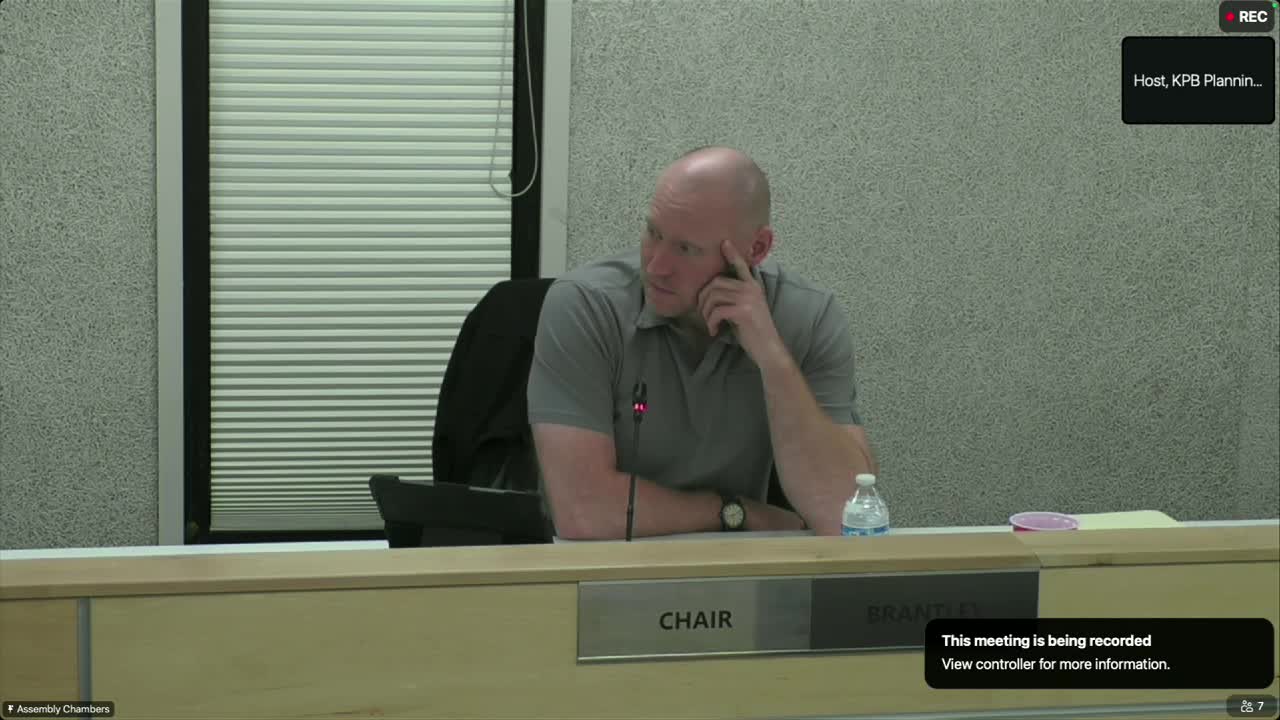Director: borough used earmark funds to remove hazard trees; code enforcement handling trespass cases
October 13, 2025 | Kenai Peninsula Borough, Alaska
This article was created by AI summarizing key points discussed. AI makes mistakes, so for full details and context, please refer to the video of the full meeting. Please report any errors so we can fix them. Report an error »

Kenai Peninsula Borough Planning Director (acting) provided updates Oct. 13 on a beetle-kill tree-removal effort funded by a congressional earmark and on the borough's approach to trespass on borough-owned parcels.
Director Ruffner told the commission that contractors had removed "almost 4,000 trees" in the Key Beach area, work done largely on private property after obtaining property-owner permission when required. The director said the removal used Firewise methods — stems saved for firewood, brush chipped or placed on the ground — and that the work cost about $84 per tree under the contract. He said the borough prioritized work around borough-owned facilities such as schools and emergency-services properties and used more than two-thirds of the earmark funds on borough properties and properties directly adjacent to them.
Ruffner said he had spoken with utility officials (HEA) and that local tree removal likely reduced the duration of power outages after a recent wind event. "Had they not done that, that power in Key Beach in particular would have been out for a whole lot longer than it turned out to be," he said.
On trespass, Ruffner confirmed the planning department has taken on several trespass cases in recent weeks. He said casual camping is allowed for up to 14 days on designated casual-use borough parcels, but patterns of long-term occupancy require a different response. The planning department's practice is to visit and assess the situation, attempt to direct people to services when appropriate, and escalate to code enforcement (which sits in the planning department) and, if necessary, the state troopers.
For members of the public or commissioners who receive complaints, Ruffner said the first contact point is the borough land management officer, Aaron Hughes, or the mayor's office, which often forwards reports to the planning department. "Ultimately that does come through the Planning Department and we'll sit down with our code enforcement officer and devise a game plan depending on the situation," he said.
The commission acknowledged the update and members thanked the director and borough assembly member Brent Johnson, who offered farewell remarks earlier in the meeting.
Director Ruffner told the commission that contractors had removed "almost 4,000 trees" in the Key Beach area, work done largely on private property after obtaining property-owner permission when required. The director said the removal used Firewise methods — stems saved for firewood, brush chipped or placed on the ground — and that the work cost about $84 per tree under the contract. He said the borough prioritized work around borough-owned facilities such as schools and emergency-services properties and used more than two-thirds of the earmark funds on borough properties and properties directly adjacent to them.
Ruffner said he had spoken with utility officials (HEA) and that local tree removal likely reduced the duration of power outages after a recent wind event. "Had they not done that, that power in Key Beach in particular would have been out for a whole lot longer than it turned out to be," he said.
On trespass, Ruffner confirmed the planning department has taken on several trespass cases in recent weeks. He said casual camping is allowed for up to 14 days on designated casual-use borough parcels, but patterns of long-term occupancy require a different response. The planning department's practice is to visit and assess the situation, attempt to direct people to services when appropriate, and escalate to code enforcement (which sits in the planning department) and, if necessary, the state troopers.
For members of the public or commissioners who receive complaints, Ruffner said the first contact point is the borough land management officer, Aaron Hughes, or the mayor's office, which often forwards reports to the planning department. "Ultimately that does come through the Planning Department and we'll sit down with our code enforcement officer and devise a game plan depending on the situation," he said.
The commission acknowledged the update and members thanked the director and borough assembly member Brent Johnson, who offered farewell remarks earlier in the meeting.
View full meeting
This article is based on a recent meeting—watch the full video and explore the complete transcript for deeper insights into the discussion.
View full meeting
